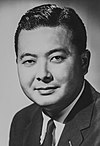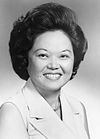Ohio's at-large congressional district existed from 1803 to 1813, from 1913 to 1915, from 1933 to 1953 and from 1963 until 1967, when it was banned by the Voting Rights Act of 1965.

Hawaii's 1st congressional district is a congressional district in the U.S. state of Hawaii. The district is entirely on the island of Oahu, encompassing the urban areas of the City and County of Honolulu, a consolidated city-county that includes Oahu's central plains and southern shores, including the towns of Aiea, Mililani, Pearl City, Waipahu, and Waimalu. The district is smaller and more densely populated than the 2nd congressional district. It is represented by Democrat Ed Case.

North Dakota's at-large congressional district is the sole congressional district for the state of North Dakota. Based on size, it is the eighth largest congressional district in the nation.
North Dakota's 1st congressional district is an obsolete congressional district in the state of North Dakota that existed from 1913 to 1933, and from 1963 to 1973.
From its statehood in 1816 until 1823, Indiana was allocated only one representative, who was elected at-large. During the 43rd Congress, from 1873 to 1875, Indiana elected three of its thirteen representatives to the United States House of Representatives at-large from the entire state.
The 40th congressional district of New York was a congressional district for the United States House of Representatives in New York. It was created in 1913 as a result of the 1910 census. It was eliminated in 1973 as a result of the 1970 redistricting cycle after the 1970 United States census. It was last represented by Henry P. Smith III who was redistricted into the 36th district.
The 43rd congressional district of New York was a congressional district for the United States House of Representatives in New York. It was created in 1913 as a result of the 1910 census. It was eliminated in 1963 as a result of the 1960 census. It was last represented by Charles E. Goodell who was redistricted into the 38th district.
At different times in its history, Washington elected one or more U.S. representatives at-large statewide.
Illinois elected its United States Representative at-Large on a general ticket upon achieving statehood December 3, 1818. It last elected a US Representative in the Election of 1946. The district has been inactive since.
Maine's 3rd congressional district is an obsolete congressional district. It was created in 1821 after Maine achieved statehood in 1820 as part of the enactment of the Missouri Compromise. It was eliminated in 1963 after the 1960 U.S. census. Its last congressman was Clifford McIntire.
Oregon's at-large congressional district is a former United States congressional district. During its existence, Oregon voters elected a Representative of the United States House of Representatives at-large from the entire state.
Nevada's at-large congressional district was created when Nevada was granted statehood in 1864, encompassing the entire state. It existed until 1983, when it eliminated as a result of the redistricting cycle after the 1980 census and subsequent reapportionment in which Nevada was awarded a second seat in the House of Representatives. Nevada began electing two representatives from separate districts commencing with the election of 1982 and the 98th Congress.

From statehood in 1896 through the creation of a second district in 1913, Utah sent one representative to the United States House of Representatives who was elected at-large statewide.
Arkansas's at-large congressional district was a congressional district for the United States House of Representatives in Arkansas from 1836 to 1885.
Florida's at-large congressional district may refer to a few different occasions when a statewide at-large district was used for elections to the United States House of Representatives from Florida. The district is obsolete.
From December 28, 1846, to March 3, 1847, the new state of Iowa was represented in the United States House of Representatives by two representatives who had been elected on a statewide basis, rather than by districts.
From statehood in 1867 until 1883, Nebraska had only one congressional district. Its representative was elected at-large statewide.
Kansas's at-large congressional district for the United States House of Representatives in the state of Kansas is a defunct congressional district. It existed from statehood January 29, 1861 to March 4, 1907.
Kansas's 6th congressional district is an obsolete district for representation in the United States House of Representatives.






